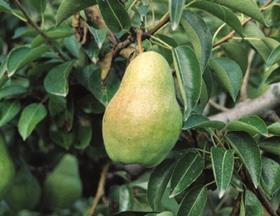
The 2017/18 Northwest pear harvest will be slightly shorter than last season according to the first official crop estimate released at the recent annual Pear Bureau Northwest meeting.
The figures point to a crop of 17.6m cartons or 390,000 tonnes, 2 per cent less than the 2016/17 harvest and 10 per cent down on the five-year average.
“Growers are reporting an excellent quality of pear crop on the trees, albeit a bit of a shorter crop than last season,” stated Kevin Moffitt, president and CEO of Pear Bureau Northwest (PBNW) the marketing organisation representing USA Pears. “At nearly 18m boxes, we expect a high quality crop in promotable numbers.”
Harvest is expected close to historical average pick dates, which is later than the last two seasons.
Starkrimson are expected in early August with Bartlett harvest expected in late August. Anjou, Bosc and Comice will be harvested beginning in September through early October. Concorde, Forelle, and Seckel will be picked in September and October, across the four growing districts.
The estimates for leading varieties include 8.9m cartons for Green Anjou, about 51 per cent of total Northwest fresh pear crop, 4.4m cartons of Bartlett (25 per cent of the total crop) and 2.2m Bosc respectively (13 per cent of the total). Red Anjou will represent 6 per cent of the crop with a potential 1.1m cartons.
Green Anjou pears are showing a projected crop increase of 7 per cent compared with a smaller crop in 2016. Growers estimate that the Bartlett pear crop will be down 4 per cent compared with last season, which is a mere 2 per cent drop off of a five-year average.
The Bosc pear crop is estimated to be well short of average, while Red Anjou production is expected to be 10 per cent higher than last year and 6 per cent above the five-year average.
The organic pear estimate comes in at 1.12m cartons (25,000 tonnes), 6.4 per cent of the total Northwest crop. This number is lower than 2016 season by 5.5 per cent, but shows a 10.5 per cent growth over the five-year average for the Northwest.
The organic Green Anjou crop is expected to be 470,000 cartons, while the Bartlett and Bosc crop sizes are estimated at 377,800 and 123,200 cartons respectively.
The export market typically accounts for around 39-45 per cent of the total sales in a given season including Mexico and Canada as the biggest of almost 30 markets, as reported by Global Trade Atlas.
PBNW’s marketing programmes will target both consumers and trade with the goal to create greater demand by increasing awareness on ripening, varieties, nutrition and usage.
Activities in top markets, including Mexico, Central America, India, Middle East and Asia will include in-store sampling, nutrition workshops, consumer advertising, movie promotional tie-ins, social media and event activations.
Larger scale special activities for the 2017/18 season include a USA Pears Road Show in India and a Luchador (Mexican wrestling) themed nutrition promotion for kids and families in Mexico.Mexico is the industry’s largest export market, and PBNWuses its proprietary retail pear category data to identify the opportunities for new varieties, size and grades of Northwest pears with the major retailers.
Display and promotion opportunities will begin in the autumn with early season programmes, leading to promotion support all season long.
Across North America, PBNW consumer outreach will focus on the health benefits of eating pears and their versatility.
Pear Bureau’s long-range planning for nutrition research will focus on the role pears play in gut health and health maintenance, working with academic advisors in nutrition to further research the benefits that drive nutrition communication outreach.
“The PBNW meeting concluded with a strong industry commitment to continue to deliver exceptional and consistent eating quality for consumers, from the first Bartlett and Starkrimson to the last Green Anjou,” Moffitt said.
“The industry is comprised of nearly 900 family growers, with 50 packing houses and 12 shipping organisations determined to produce the finest pears in the world with a taste profile that surpasses any and all SKUs in the produce department.”






No comments yet